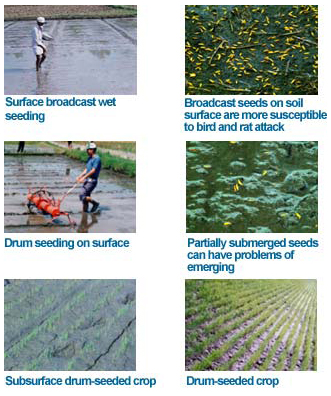Wet direct seeding
What is wet direct seeding?
 In wet direct seeding, seed is normally pre-germinated prior to broadcasting onto recently drained, well-puddled seedbeds or into pre-standing water in the fields. Wet direct seeding more commonly used in irrigated areas.
In wet direct seeding, seed is normally pre-germinated prior to broadcasting onto recently drained, well-puddled seedbeds or into pre-standing water in the fields. Wet direct seeding more commonly used in irrigated areas.
Why use wet direct seeding?
- Easier (less work involved) and more timely crop establishment
- Reduced labor costs for crop establishment
- Possible savings in water consumption
How do you wet direct seed?
- Ensure the field is well-leveled, well-puddled and weed free
- Plant in the field within 2−5 days after the final puddling. At this point the soil has settled to be solid enough to hold seed on or near the surface and weeds are not yet established. If seed is planted more than 1 cm deep, it will usually have problems emerging.
- In drained fields, small canals can be made across the field a couple of days after puddling to further help drain the field and avoid snail damage and seed emergence problems in areas with standing water.
- Pre-germinate the seed (soak for 24 hrs in water, cover and drain for 24 hrs). In this time the seedling root will emerge 2−3 mm. If the seed is left longer, it becomes entangled making it difficult to separate seed and thus causing damage to the seed when planted.
- Use sufficient number of seeds - of a variety suited for direct seeding - to achieve a plant population of 100−150 plants/m2. This will usually require around 80 kg seed/ha. Use an extra 10-20% if the seed is not pregerminated. Farmers often use more seeds (e.g., up to 150−200 kg/ha) because of poor field leveling, poor seed and seed losses to birds and rats).
- If the fields is muddy, following the last working, allow the field to dry for a time period of at least 24 hrs (preferably 48 hrs) before commencing broadcasting.
- Sow the seed uniformly: Mark the field in 5 m wide strips (the typical distance over which seed can be uniformly distributed by hand). Divide the seed into uniform lots to allow the person sowing to sow the field and back (i.e., a 10 m wide strip) before getting the next seed lot. (e.g., the field is 20 m wide, then there will be 4 passes of 5 m each and the seed should be divided into 2 equal size seed lots).
- Broadcast the seed into 2−5 cm of standing water or onto the drained field. If the field is drained, then the soil should hold a “v” shape when a stick is run through the mud. This indicates a soil consistency that will prevent seed sinking too deep.
- Let the water drain before flash flooding after 2−3 days to keep seed moist and to reduce soil crusting (this is especially important in the dry season)
- If the water is drained for 10 to 15 days after establishment. In some irrigation areas, seedlings are broadcast post-germination with seedlings 100 to 300 mm in length.
Limitations:
- Good land preparation, leveling, and water management are needed for a uniform crop establishment.
- Weeds are a very serious problem in dry and wet seeding.
- Snails (in wet-seeded fields), rats, and birds can severely damage plant stands.
- Heavy rainfall at the time of crop establishment can adversely affect the crop establishment failure (especially in heavier clay soils), and if the water sits over seed while still germinating below the soil.
- Longer occupation of main field by 5−15 days, compared to transplanted rice.
- High water and nutrient use in dry seeding (due to high percolation especially on light soils).
Developed with input from MA Bell, JF Rickman, and V Balasubramanian







